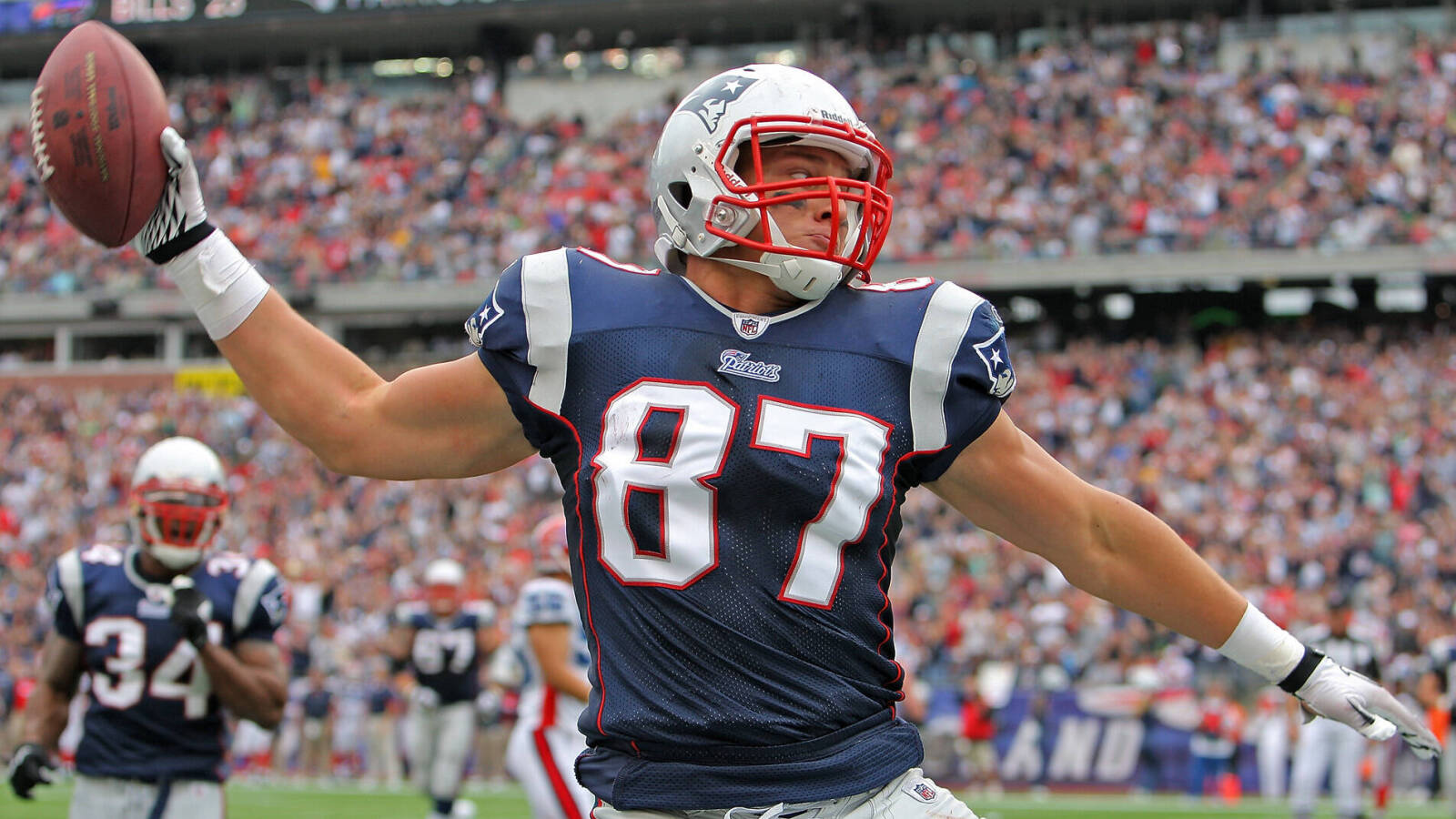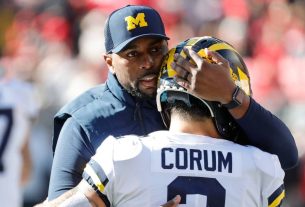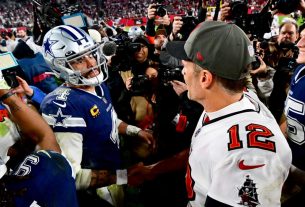Eight teams traded out of the 2022 first round, giving some fanbases an additional wait. But the second round of the draft has produced Hall of Famers for several teams and longtime starters for others. Here is the best second-round pick each of the NFL’s 32 teams has made in the common draft era (1967-present).
1 of 33
Every NFL team’s best second-round draft pick
Matt Stone/MediaNews Group/Boston Herald via Getty Images
Trades that strip teams of first-round picks are becoming increasingly more common, raising the stakes for the second round. Round 2 has produced Hall of Famers for several teams and longtime starters for others. Here is the best second-round pick each of the NFL’s 32 teams has made in the common draft era (1967-present).
2 of 33
Arizona Cardinals: Dan Dierdorf
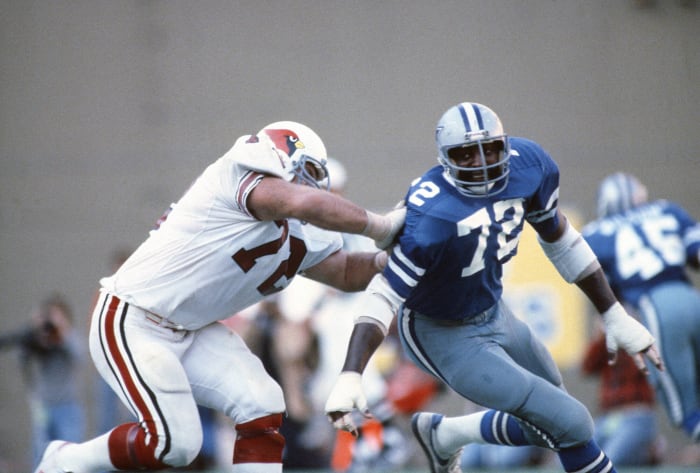
Focus on Sport/Getty Images
Dierdorf’s broadcasting career and his having played two non-strike-year playoff games in 13 years may have resulted in him being a bit overlooked. But the 1971 second-round pick dominated at right tackle throughout the ’70s, when that position enjoyed a higher profile than it does today, en route to the All-Decade team and Hall of Fame. The Cardinals chose Dierdorf 43rd overall and also used him at guard, center, and left tackle. St. Louis’ mid-1970s rise can be attributed to Don Coryell’s offense, but Jim Hart, Terry Metcalf, and Co. benefited from a wall of Pro Bowlers that also included center Tom Banks and guard Conrad Dobler.
3 of 33
Atlanta Falcons: Brett Favre
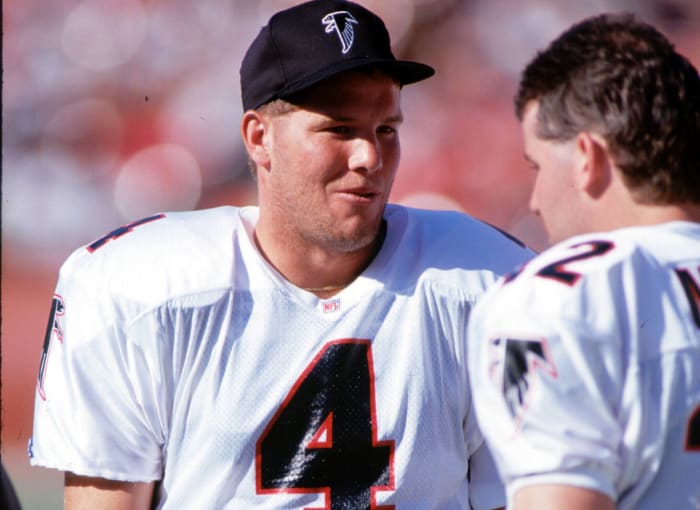
Kevin Reece/Icon Sportswire
The Falcons took Favre 33rd overall in 1991, as the infamous dorm-room jorts photo illustrates, but traded him after one season. This infamous transaction came after Atlanta’s third-string rookie rubbed some, including head coach Jerry Glanville, the wrong way. Off-field behavior, poor playbook comprehension, and in-season weight gains led to just four Favre pass attempts in 1991 when he sat behind Chris Miller and Billy Joe Tolliver. Favre never completed a pass with the Falcons, and Glanville signed off on trading him for a 1992 first-round pick (running back Tony Smith) in the offseason. He fared better in Green Bay.
4 of 33
Baltimore Ravens: Ray Rice
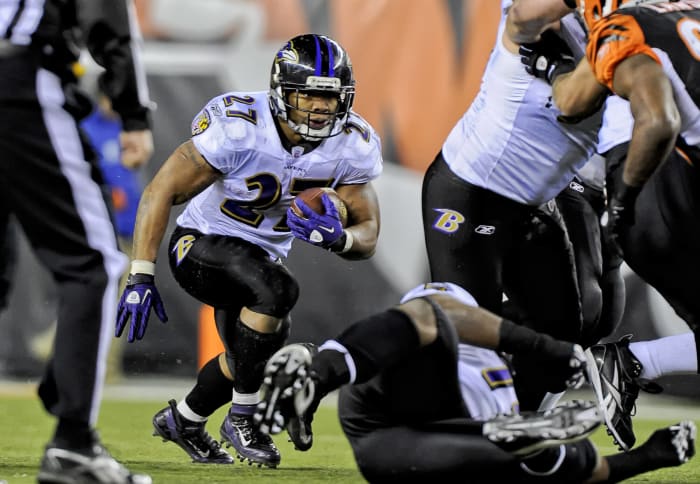
MSA/Icon Sportswire
Baltimore cut longtime starter Jamal Lewis in February 2008 and soon drafted Rice 55th overall. This came after the Ravens traded down 17 spots in Round 2, via the Seahawks. The compact dynamo Baltimore drafted went to three Pro Bowls and stacked together four straight 1,100-yard seasons (2009-12), the last of which came in the Ravens’ Super Bowl XLVII-winning campaign. The Ravens gave Rice an extension in 2012 but saw his numbers tail off by 2013, just prior to his career-ending act of domestic violence.
5 of 33
Buffalo Bills: Thurman Thomas

Ronald C. Modra/Getty Images
Linked heavily to first-round status, Thomas endured a long, sleep-inducing wait during the 1988 draft. The future Hall of Famer lasted until pick No. 40. Gaston Green, John Stephens, Lorenzo White, Brad Muster, Craig “Ironhead” Heyward, Ickey Woods, and Tony Jeffery were taken before Thomas in a running back-rich draft. The player who kept Barry Sanders on the bench at Oklahoma State rewarded the Bills, with his dual-threat skillset ideal for their burgeoning K-Gun offense. Thomas led the NFL in scrimmage yards for four straight years, earned 1991 MVP honors, and played 12 seasons in Buffalo.
6 of 33
Carolina Panthers: Ryan Kalil
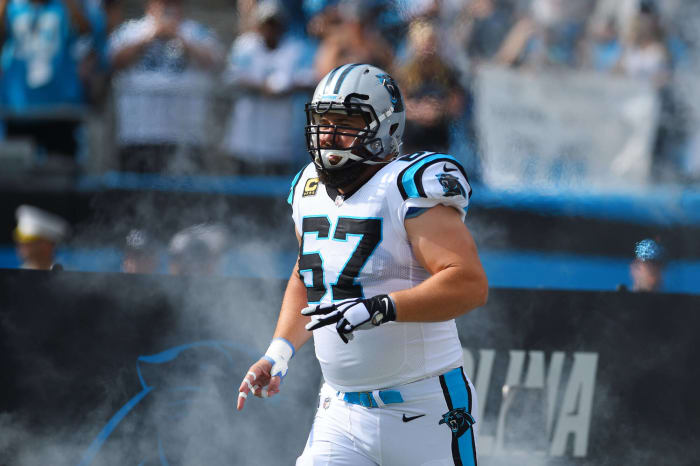
Bob Donnan-USA TODAY Sports
Although Kalil battled injuries during his 12-year Carolina run, he was a constant for the team during playoff journeys at the close of Jake Delhomme’s career and the entirety of Cam Newton’s prime. The Panthers landed Kalil near the end of the 2007 second round (59th overall). The USC center was part of the trade that allowed the Jets to move up 11 spots in Round 1 to take Darrelle Revis. The Panthers used the extra second-rounder to make Kalil the first center taken in 2007, one spot ahead of Samson Satele, who went to the Dolphins. Kalil started 145 games (fourth-most in Panthers history) and made five Pro Bowls.
7 of 33
Chicago Bears: Mike Singletary

David Madison/Getty Images
The Chargers and Chiefs spoke to Singletary about potential first-round investments in 1981, but the Baylor linebacker fell to the Bears at No. 38. This draft equipped three 1980s NFC superpowers with defensive cornerstones, with Lawrence Taylor going to the Giants and Ronnie Lott to the 49ers. Those first-ballot Hall of Famers went off the board in the top 10. Despite Singletary’s name staying on draft boards longer, he made a similar impact. “Samurai Mike” anchored famed Bears defenses — most famously 1985’s legendary unit — won two Defensive Player of the Year honors and made the Pro Bowl in his final 10 seasons.
8 of 33
Cincinnati Bengals: Boomer Esiason

George Gojkovich/Getty Images
Second-round success has been crucial for the Bengals, who nabbed three Super Bowl LVI starters (Joe Mixon, Tee Higgins, Jessie Bates) and landed standouts Bill Bergey and Carl Pickens there in decades prior. No one was as important to the franchise than its 1984 second-round choice. Esiason represented the prize of a doubted 1984 quarterback class. After six QBs went off the board in the 1983 first round, Esiason (38th overall) was the only one selected in the first two rounds in ’84. The brash southpaw succeeded Ken Anderson and followed his arc by winning an MVP award during a Super Bowl season. Esiason played 10 seasons as a Bengal.
9 of 33
Cleveland Browns: Michael Dean Perry

George Gojkovich/Getty Images
Nick Chubb and Joel Bitonio have nearly closed the gap here, but a Browns 1.0 performer still has them beat. Perry was one of the NFL’s best defensive tackles for a while. In the sack era, only Myles Garrett has more sacks with the Browns than Perry, who in some ways is overshadowed by his less talented older brother (William “The Refrigerator” Perry). The Browns took the younger Perry 50th overall in 1988 and saw him earn All-Pro acclaim by his second season. Perry (51.5 sacks as a Brown) helped the Browns to the 1989 AFC title game and earned six Pro Bowl trips in a 10-year career.
10 of 33
Dallas Cowboys: Larry Allen

James D. Smith/Icon Sportswire
The Cowboys bolstered their historically elite offensive line with a Division II guard, selecting Allen 46th overall in 1994. The future John Madden favorite joined Nate Newton, Mark Tuinei, Erik Williams, and Ray Donaldson on a Cowboys 1995 Super Bowl-winning O-line that featured five Pro Bowlers. While playoff success eluded Dallas’ dynasty henceforth, Allen became one of the best guards ever. The terrifyingly strong Sonoma State alum made 10 Pro Bowls from 1995 to 2006 and is the rare player to land on two All-Decade teams. He of a bench-press max beyond 700 pounds, Allen used that strength to become a cinch Hall of Famer.
11 of 33
Denver Broncos: Curley Culp

Cliff Welch/Icon Sportswire
Not the most well-run organization during the AFL days, the Broncos drafted Culp in the 1968 second round but traded him to the Chiefs for a fourth-rounder before he played a game for them. After a developmental year, Culp moved into a dominant Chiefs defensive lineup in 1969. The defensive tackle out of Arizona State was one of six Hall of Fame-bound players on Kansas City’s Super Bowl-winning defense, and he later joined two more eventual Canton cogs (Elvin Bethea, Robert Brazile) in Houston after being traded to the Oilers in 1974. Culp shined inside for rejuvenated Oilers teams in the late ’70s, cementing his Hall case.
12 of 33
Detroit Lions: Lem Barney

Focus on Sport/Getty Images
The Lions broke in the common draft era by taking Barney 34th overall out of Jackson State in 1967. Barney delivered one of the best rookie years in NFL annals by intercepting 10 passes and returning three for touchdowns (one coming on a Bart Starr pass on the second play of the Detroit cornerback’s career). Moonlighting as Detroit’s punter for a bit and running his career TD total to nine via three return scores, Barney finished his career with 56 INTs and seven Pro Bowls, making No. 20 famous in Detroit ahead of Billy Sims and Barry Sanders’ arrivals.
13 of 33
Green Bay Packers: LeRoy Butler

Jonathan Daniel/Allsport/Getty Images
Butler became the last offensive or defensive starter on the 1990s’ All-Decade team chosen for Canton enshrinement, following fellow safety Steve Atwater as a belated selection. Butler’s hits lacked the impact of Atwater’s, but he proved versatile for the Packers during a 12-year career spent entirely in Green Bay. Butler finished his career with 38 INTs and 20.5 sacks. Of the Packers’ Super Bowl XXXI starters, Butler arrived first (48th overall in 1990). Moved from cornerback to safety early in his career, the Lambeau Leap originator earned more All-Pro honors (four) than any safety in the ’90s.
14 of 33
Houston Texans: DeMeco Ryans
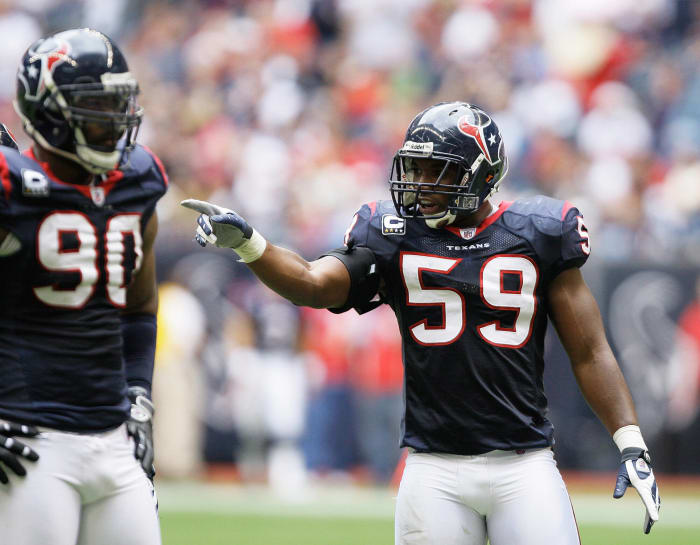
Bob Levey/Icon Sportswire
Ryans may now be better known for his tactical acumen than his on-field chops. But the new Texans head coach was one of the NFL’s better inside linebackers during his 10-year career. The Texans stocked up on defense in 2006, surprising most by taking Mario Williams over Reggie Bush, and began the second round by selecting Ryans at No. 33. Ryans started every game he played in six Texans seasons, voyaging to two Pro Bowls and helping the franchise snap its playoff drought in 2011. Houston traded Ryans to Philadelphia shortly after. While Ryans wrapped his career in Philly, he is back in H-Town on a six-year HC contract.
15 of 33
Indianapolis Colts: Ted Hendricks
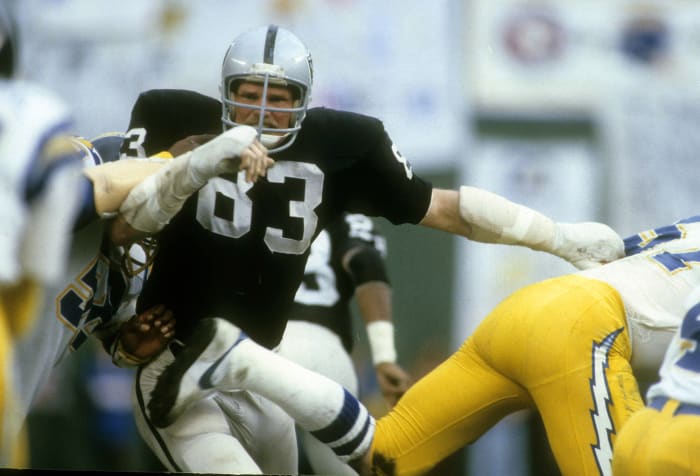
Focus on Sport/Getty Images
Unique in proportions and personality, Hendricks was a mainstay for three Super Bowl-winning teams. Although the 6-foot-7 outside linebacker is best known for his Raiders years, he was an All-Pro as a Colt as well. Baltimore drafted Hendricks 33rd overall in 1969, with the ex-Miami Hurricane’s slender frame leading to a draft fall. The lanky star, who was part of the 1970 Colts’ Super Bowl team, retired after 15 seasons with 26 INTs, 61 sacks, and a record 25 blocked kicks. The rebuilding Colts traded Hendricks to the Packers in 1974; contract demands led Green Bay to send him to Oakland in ’75. That proved an ideal fit; Hendricks was a Raider starter until his final season in 1983.
16 of 33
Jacksonville Jaguars: Maurice Jones-Drew

Margaret Bowles/Icon Sportswire
The fantasy football enthusiast satisfied scores of fantasy GMs for years in Jacksonville, producing regardless of the product the Jaguars put on the field. The Jags drafted Jones-Drew 60th overall out of UCLA in 2006 and put him to work immediately alongside stalwart Fred Taylor. This duo gashed defenses during its short time together, and Jones notched 15- and 14-touchdown seasons in his first three years. This did not earn the 5-foot-7 back Pro Bowl acclaim, but he achieved it for bottom-tier Jags squads later. Jones-Drew won the 2011 rushing title for a 5-11 team and spent eight years in Jacksonville.
17 of 33
Kansas City Chiefs: Willie Lanier
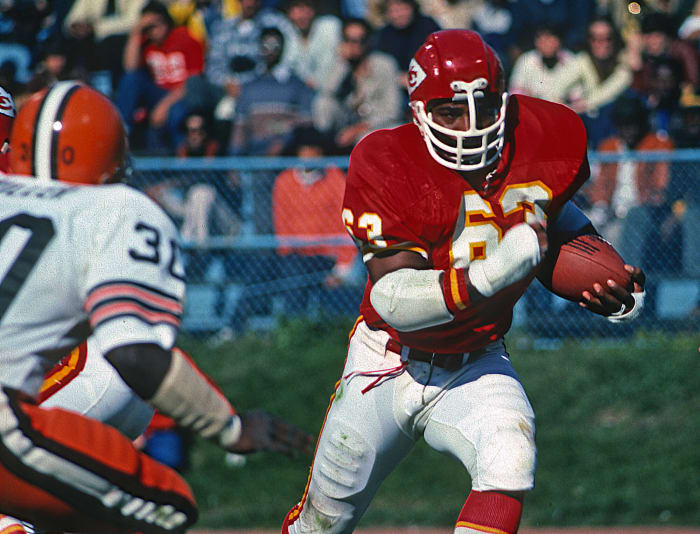
George Gojkovich/Getty Images
Already equipped with one of the most athletic linebackers in NFL history in Bobby Bell, the Chiefs added long-term starter mates at the position in the 1967 second round. Kansas City drafted Jim Lynch and Lanier three picks apart (Nos. 47 and 50, respectively). Both were 11-year starters for the Chiefs, who deployed Lanier as a difference-making middle ‘backer from the jump. The fearsome tackler teamed with Bell to steer the Chiefs to a runaway Super Bowl IV win, and although the franchise’s trajectory veered off the championship tier in the second half of Lanier’s career, the future Hall of Famer kept racking up Pro Bowls.
18 of 33
Las Vegas Raiders: Howie Long

Owen C. Shaw/Getty Images
Long’s second career has dwarfed his first in longevity, but it should not obscure the Villanova alum’s run as one of the NFL’s top defensive linemen. The Raiders landed Long via a lopsided 1980 trade when they sent Dave Casper to the Oilers for a first-round pick and two seconds. The flat-topped pass rusher — chosen 48th overall — delivered in a variety of roles during the Raiders’ Los Angeles years, dominating outside in 3-4 looks and inside in 4-3 alignments. Long broke into the Raiders’ starting lineup for good in 1983, helping them cruise through the playoffs toward a Super Bowl XVIII rout. The FOX mainstay later cruised to the Hall of Fame.
19 of 33
Los Angeles Chargers: Drew Brees
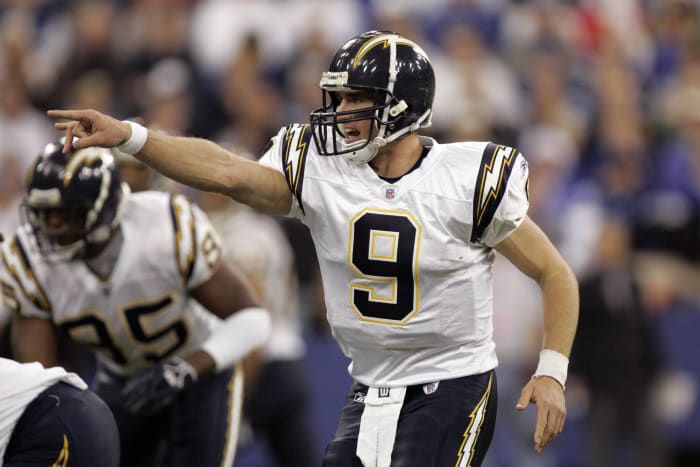
Mark Cowan/Icon Sportswire
Rather than take Michael Vick first overall in 2001, the Chargers traded down to No. 5 and drafted a first-ballot Hall of Famer (LaDainian Tomlinson), and added a future first-ballot inductee in Round 2. Brees came to San Diego as the first pick in that second round. Although the Purdue product’s early-career struggles led the Chargers to “draft” Philip Rivers fourth overall in 2004, complicating matters at QB, Brees was trending upward before the December 2005 shoulder injury ended his Bolts run. The Bolts only received a compensatory pick for Brees’ 2006 exit, when the Saints made the greatest free-agent signing in NFL history.
20 of 33
Los Angeles Rams: Isaac Bruce
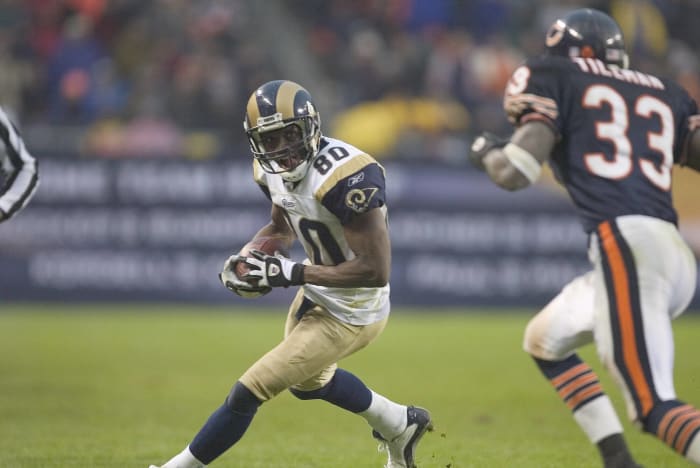
Todd Rosenberg/Icon Sportswire
Bruce narrowly clips 1983 second-rounder Henry Ellard here. The Rams moved on from Ellard the same year (1994) they drafted Bruce 33rd overall out of Memphis State. Ellard anchored the Rams’ Jim Everett teams; Bruce became the centerpiece of the Kurt Warner squads with that snazzy “Greatest Show on Turf” nickname. Bruce first toiled on unmemorable Rams teams, becoming an elite Pro Bowl snub amid his 1,781-yard 1995 season. But he remained in his prime as Warner broke out. The recent Hall of Fame inductee’s 80-yard Super Bowl game-winner gave the Rams their first Super Bowl title. Bruce played 16 seasons — 14 with the Rams.
21 of 33
Miami Dolphins: Dwight Stephenson

George Gojkovich/Getty Images
Perhaps the most talented center ever fell to the No. 48 slot in the 1980 draft, though the Dolphins did make him the first snapper taken that year. Stephenson towered over his positional peers for much of the 1980s, providing a sturdy runway for Dan Marino’s rapid ascent to stardom. A knee injury sustained on a November 1987 Monday night ended Stephenson’s career in his eighth season, but he finished his NFL run with four straight first-team All-Pro appearances. Stephenson later joined Jim Langer and Larry Little as Dolphins O-linemen in the Hall of Fame.
22 of 33
Minnesota Vikings: Matt Blair

Focus on Sport/Getty Images
Coming off a Super Bowl VIII appearance, the Vikings nabbed Blair with the penultimate pick of the 1974 second round. While Blair did not enter his prime until Minnesota’s run of NFC titles was over, he shined as an outside linebacker and kick-blocker well into the 1980s. Blair registered 23 sacks, recovered 20 fumbles, and blocked over 20 kicks or punts as a pro. His most famous block came in Super Bowl IX as a rookie, with that play accounting for the Vikes’ lone score that day. Blair played 12 seasons, all with the Vikings.
23 of 33
New England Patriots: Rob Gronkowski

Timothy T. Ludwig-USA TODAY Sports
The pick that became Gronkowski (No. 42 in 2010) changed hands three times, going from the Bears to the Buccaneers to the Raiders to the Patriots. Bill Belichick traded up two spots to acquire the 21-year-old pass-catcher out of Arizona. That decision went a long way to the Patriots claiming championships 4-6; Gronkowski gave Tom Brady an unrivaled weapon during most of the 2010s. Gronk’s 17 TD catches in 2011 remain a tight end record, and he spent the next several years submitting a strong argument as the most dominant tight end ever. Brady felt the lock Hall of Famer’s absence his New England finale (Gronk’s 2019 WWE sabbatical) and Tampa signoff (a 2022 exit that looks permanent).
24 of 33
New Orleans Saints: Rickey Jackson

Focus on Sport/Getty Images
The Chargers took an early lead in the 1980 trade that sent running back Chuck Muncie to San Diego for a 1981 second-round pick, but the Saints ended up winning by a wide margin. New Orleans took Jackson 51st overall, and the Pitt product became one of the best players in team history. The outside linebacker was the first player to spend the bulk of his career with the Saints and make the Hall of Fame. A 13-year Saint, Jackson registered 136 sacks, forced 40 fumbles, and led the team’s Dome Patrol linebacking corps of the late 1980s and early ’90s. That group played a major role in the team’s first batch of playoff berths.
25 of 33
New York Giants: Michael Strahan

Lee S. Weissman/Icon Sportswire
Playing long enough to be part of three memorable Giants eras — the LT/Phil Simms period, Jim Fassel’s Super Bowl XXXV group, and the initial Eli Manning teams — Strahan began his career as a second-round pick (40th overall in 1993) from a small school. The Texas Southern alum became one of the most famous NFLers ever, largely on his post-career success. On the field, the powerful defensive end beat right tackles regularly on his way to 141.5 career sacks (a record 22.5 in 2001). Strahan remained a key performer through his age-36 season in 2007, a rather memorable Giants campaign that involved a Super Bowl LII sack from the soon-to-be TV star.
26 of 33
New York Jets: Mark Gastineau
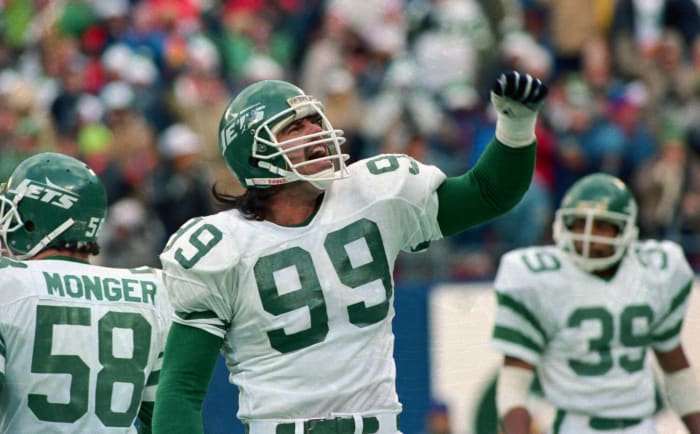
Bettmann/Getty Images
Gastineau, an Arizona State transfer, caught the Jets’ eye out of East Central (Oklahoma) in 1979. The Jets took the boisterous defensive end 41st overall; he soon led the way to the NFL finally seeing a major change in defensive stat-keeping. Gastineau and D-line mate Joe Klecko’s 40.5 combined sacks in 1981 proved vital to the NFL making the sack a full-fledged statistic. This cleared the way for Gastineau, the top rusher in the New York Sack Exchange, to hold the recognized sack record (22) for nearly 20 years. Gastineau played 10 seasons with the Jets, boosting them to four playoff berths in the 1980s.
27 of 33
Philadelphia Eagles: Brian Dawkins

Brian Garfinkel/Icon Sportswire
The Eagles extracted immense value from their No. 61 overall pick in 1996, seeing Dawkins play 16 seasons and become the leader on the team’s string of NFC title game-qualifying defenses. Philly has made several strong second-round picks — from Randall Cunningham to Eric Allen to LeSean McCoy to DeSean Jackson to Jalen Hurts — but Dawkins’ 13-season stay and Hall of Fame status wins out. The hard-hitting defender made plays consistently, racking up 36 forced fumbles and 26 sacks, and was still on the Pro Bowl tier during his late-30s seasons with the Broncos. He did plenty to secure the Eagles Super Bowl XXXIX access.
28 of 33
Pittsburgh Steelers: Jack Ham and Jack Lambert
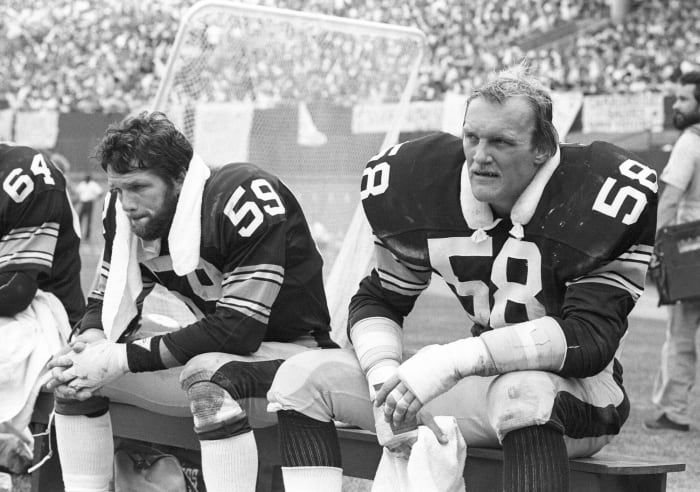
Bill Amatucci Collection/Diamond Images/Getty Images
The Steelers used the second round to build the Steel Curtain’s second level, drafting Ham 34th overall (Penn State) in 1971 and Lambert 46th (Kent State) in 1974. The teammates had disparate styles, with Ham a well-rounded linebacker who thrived in coverage (32 interceptions) and Lambert a tenacious player who intimidated opponents despite an undersized frame. Each was integral to Pittsburgh’s dominance. Ham and Lambert tallied six All-Pro bids apiece, teaming up on all four of the Steelers’ Super Bowl-winning squads in the ’70s. Both Jacks were first-ballot Hall of Famers.
29 of 33
San Francisco 49ers: Roger Craig

Owen C. Shaw/Icon Sportswire
This is an example of both a player finding the perfect landing spot and a coach coaxing extraordinary production from a second-round fullback. Despite Craig coming from wishbone-centric Nebraska, where he caught 16 passes, Bill Walsh deployed 1983’s No. 49 overall pick as a lethal chess piece out of the backfield. The 49ers landed Craig after trading out of the first round, via the Chargers, picking up two second-round picks. Craig shined as a receiver as both a fullback and halfback, making four Pro Bowls. He scored three TDs in Super Bowl XIX and became the NFL’s first 1,000-1,000 player in 1985, which doubled as one of the NFL’s versatility apexes.
30 of 33
Seattle Seahawks: Bobby Wagner
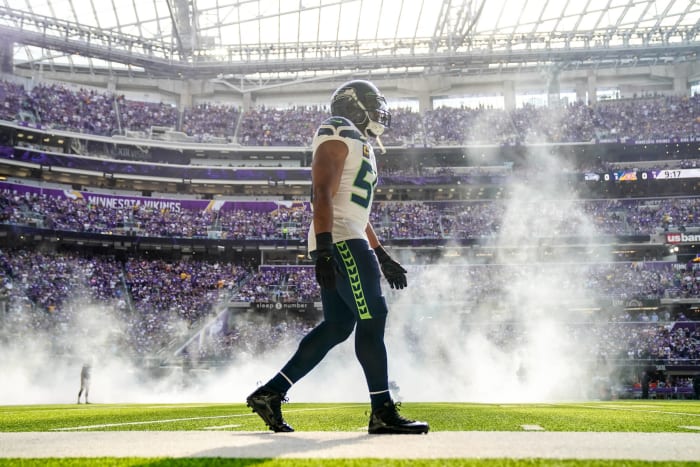
Brace Hemmelgarn-USA TODAY Sports
The Seahawks managed to grab Wagner despite trading down four spots, via a Jets move for wide receiver Stephen Hill. On a seminal night for Seattle, which selected Wagner and Russell Wilson on Day 2 of the 2012 draft, the No. 47 overall pick became his class’ most decorated player. Wagner took a publicity backseat to the Legion of Boom during the Seahawks’ Super Bowl years, but the Utah State alum’s prime has outlasted each LOBer’s. The do-it-all middle linebacker has more first-team All-Pros (six) than any active player and added a second-team honor with the Rams in 2022. The Seahawks have since re-signed Wagner after his L.A. one-off.
31 of 33
Tampa Bay Buccaneers: Lavonte David
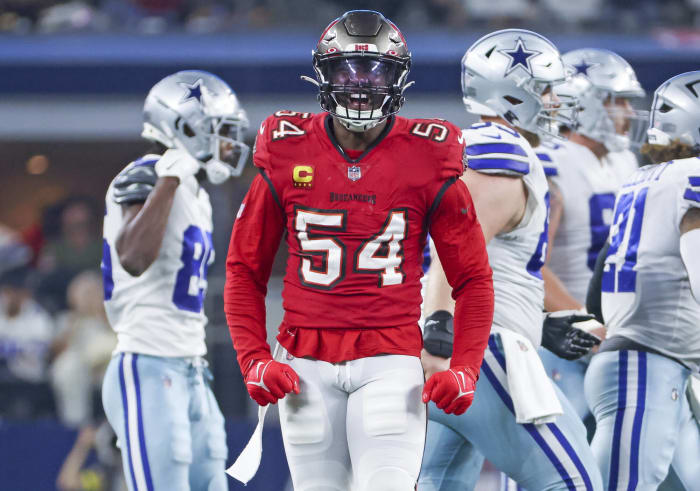
Kevin Jairaj-USA TODAY Sports
Narrowly edging Mike Alstott, David has become one the 21st century’s best off-ball linebackers. Only Derrick Brooks and Ronde Barber have started more games among Buccaneers defenders than David’s 166. The 2012 No. 58 overall pick’s resume includes just one Pro Bowl, but the league’s all-star voting features an antiquated selection setup that often sees edge rushers cannibalize off-ball linebackers. David (nine 100-tackle seasons) toiled for years on struggling Bucs teams but was still in his prime by the time Tom Brady arrived in 2020. Mentoring Devin White, David was instrumental in the Bucs’ defense dominating the Chiefs in Super Bowl LV.
32 of 33
Tennessee Titans: Derrick Henry
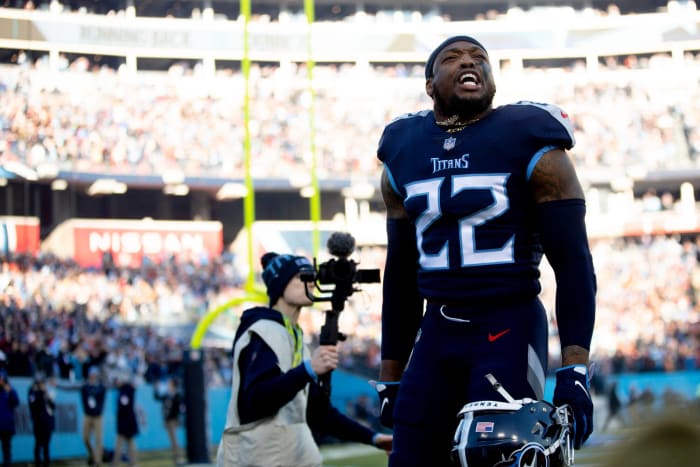
Albert Cesare/The Enquirer/USA TODAY NETWORK
The Titans obtained the Henry pick (No. 45 overall) in the Rams’ 2016 trade-up for Jared Goff. After drafting their hopeful franchise quarterback in 2015, the Titans placed two Heisman winners in their backfield in Henry and Marcus Mariota. The Goff trade also gave the Titans the Corey Davis and Jonnu Smith choices, but Henry has been the easy standout from the swap. DeMarco Murray held onto the Titans’ starting job during most of Henry’s first two seasons. This oddly benefited the Alabama-developed bulldozer, who was subsequently fresher for better Titans teams. The result: the NFL’s first back-to-back rushing champion since LaDainian Tomlinson.
33 of 33
Washington: Jon Jansen
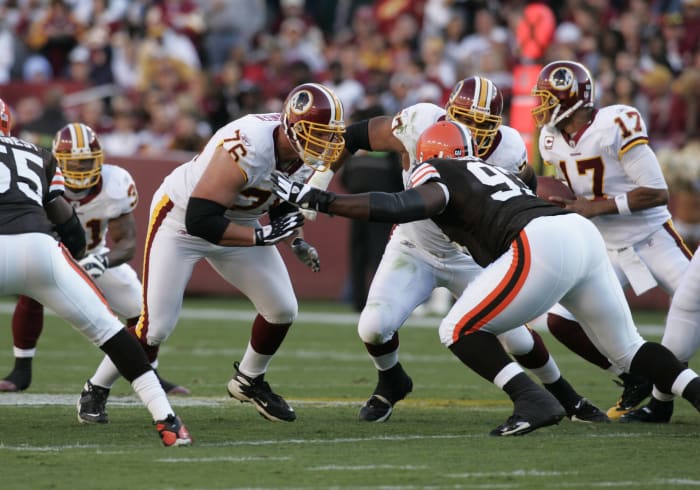
Jeff Fishbein/Icon Sportswire
Washington traded up three spots for Jansen in 1999, selecting him 37th overall. The ex-Tom Brady protector at Michigan did not become a Pro Bowler, but Jansen was one of the 2000s’ best right tackles. Though 4-3 outside linebackers get the Pro Bowl shaft, the all-star event’s flawed voting system punishes right tackles more. Jansen teamed with left tackle Chris Samuel to give Washington one of the NFL’s top tackle tandems for most of the 2000s. The duo guided Clinton Portis to some solid seasons after his 2004 trade arrival. Jansen was the team’s right tackle starter through 2008.
